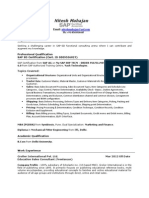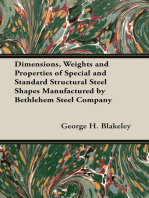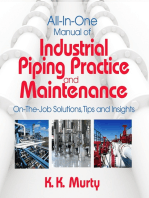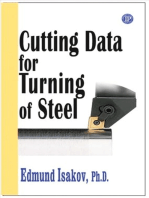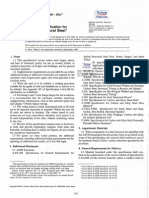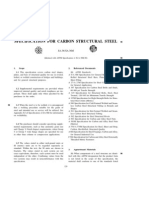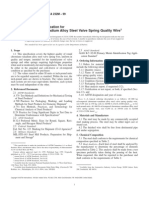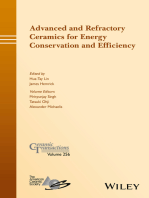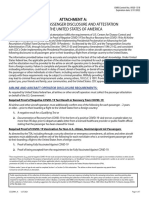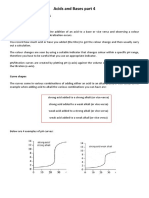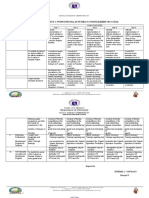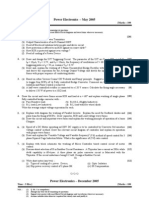0 ratings0% found this document useful (0 votes)
91 viewsDR 600001
DR 600001
Uploaded by
UditChampaneriaThis document outlines specifications for gray iron castings intended for use in pressure-containing parts down to -60°F. It specifies requirements for chemical composition, mechanical properties tested via tensile strength, quality standards, microstructure, pressure tightness testing, inspection and rejection. Castings must meet ASTM A278 specifications for gray iron and ASME and API pressure vessel codes. Tests ensure castings meet a Class 40 tensile strength of 40 ksi and contain the specified graphite and carbide microstructure.
Copyright:
© All Rights Reserved
Available Formats
Download as PDF, TXT or read online from Scribd
DR 600001
DR 600001
Uploaded by
UditChampaneria0 ratings0% found this document useful (0 votes)
91 views4 pagesThis document outlines specifications for gray iron castings intended for use in pressure-containing parts down to -60°F. It specifies requirements for chemical composition, mechanical properties tested via tensile strength, quality standards, microstructure, pressure tightness testing, inspection and rejection. Castings must meet ASTM A278 specifications for gray iron and ASME and API pressure vessel codes. Tests ensure castings meet a Class 40 tensile strength of 40 ksi and contain the specified graphite and carbide microstructure.
Copyright
© © All Rights Reserved
Available Formats
PDF, TXT or read online from Scribd
Share this document
Did you find this document useful?
Is this content inappropriate?
This document outlines specifications for gray iron castings intended for use in pressure-containing parts down to -60°F. It specifies requirements for chemical composition, mechanical properties tested via tensile strength, quality standards, microstructure, pressure tightness testing, inspection and rejection. Castings must meet ASTM A278 specifications for gray iron and ASME and API pressure vessel codes. Tests ensure castings meet a Class 40 tensile strength of 40 ksi and contain the specified graphite and carbide microstructure.
Copyright:
© All Rights Reserved
Available Formats
Download as PDF, TXT or read online from Scribd
Download as pdf or txt
0 ratings0% found this document useful (0 votes)
91 views4 pagesDR 600001
DR 600001
Uploaded by
UditChampaneriaThis document outlines specifications for gray iron castings intended for use in pressure-containing parts down to -60°F. It specifies requirements for chemical composition, mechanical properties tested via tensile strength, quality standards, microstructure, pressure tightness testing, inspection and rejection. Castings must meet ASTM A278 specifications for gray iron and ASME and API pressure vessel codes. Tests ensure castings meet a Class 40 tensile strength of 40 ksi and contain the specified graphite and carbide microstructure.
Copyright:
© All Rights Reserved
Available Formats
Download as PDF, TXT or read online from Scribd
Download as pdf or txt
You are on page 1of 4
DRESSER-RAND
Painted Post Operations
60,006
Edition 1
Material Specification
Gray Iron Castings for Pressure-Containing Parts to Minus 60F (Minus 51C)
Note: The most recent changes are indicated with an asterisk (*).
1. SCOPE:
1.1 This Specification covers a Class 40 gray cast iron suitable for pressure-
containing parts for use at temperatures down to 60F (51C), conforming with
the basic requirements of ASTM A278, date of latest issue.
1.2 Castings to this specification shall be in compliance with SA 278, Section II of
the ASME Boiler and Pressure Vessel Code and American Petroleum Institute
Standard 618, dates of latest issue.
1.3 Castings to this Specification shall be a Class 40 gray iron [i.e., 40 ksi (276 MPa)
tensile strength] when tested in accordance with Paragraph 5 of this
Specification.
2. MELTING PRACTICE:
2.1 The type of melting unit and choice of melting procedure are optional with the
manufacturer. Ladle inoculation is recommended but is left to the discretion of
the supplier so long as the specified properties are produced.
3. CHEMICAL COMPOSITION:
3.1 Castings to this specification shall be of the following chemical composition:
C Si Mn P S Mo
% Minimum 3.30 1.60 0.25
% Maximum 3.50 1.80 0.90 0.065 0.12 0.35
3.2 Heat analysis records must be maintained by the manufacturer for verification of
compositional control.
4. STRESS RELIEVING:
4.1 A subcritical stress relief anneal is required when so designated by an Dresser-
Rand Heat Treatment Standard on the casting drawing. Test bars or coupons
shall be heated in the same furnace charge and immediately adjacent to the
castings they represent.
5. MECHANICAL PROPERTIES:
5.1 The manufacturer shall cast test bars or integrally cast coupons in accordance
with the requirements of ASTM A278, to ensure the compliance of each casting
lot or individual casting over 2000 lbs (907 kg). Results shall be recorded and
maintained on file for inspection by Dresser-Rand Company. (A lot is defined as
that metal, of controlled chemical composition, which is poured during one
working shift from the same melting unit employing continuous practice, or from
the same heat in a batch operation.)
5.1.1 The cast test bar and machined specimen sizes shall be determined on
the basis of the casting controlling section per the correlation established
in ASTM A278. The correlation for section sizes beyond 2 inches (50 mm)
shall be extended in accordance with the S(1), S(2) and S(3) test bars
defined in Table I.
5.1.2 Except as permitted in Paragraph 5.1.4, test bars shall be separate
castings poured from the same iron as the castings they represent, and
shall have dimensions as shown in Table II.
5.1.3 For castings having a controlling section greater than 2 inches (50 mm),
where it is impractical to establish a satisfactory degree of correlation
between test bars and castings, the castings shall be considered as
having met the tensile strength of the class specified when test coupons
cut from the castings or integral projections thereof, the cross section of
which is not less than that of the controlling section of the casting, have a
tensile strength not less than 80 percent of the specified class.
5.1.4 Castings weighing in excess of 2000 lbs (907 kg) may be represented
either by separately cast test bars poured from the same ladle of iron or
by integrally cast test bars having a cooling rate closely approximating that
of the controlling section of the casting, upon prior agreement between
Dresser-Rand and the casting supplier.
6. QUALITY REQUIREMENTS:
6.1 The casting shall conform substantially to the dimensions on drawings furnished
by Dresser-Rand Company.
6.2 Castings, as received by Dresser-Rand Company, shall be well cleaned with
fins, risers and gates removed; and free from fused-on sand, shrinkage cavities,
sand holes, cracks, excessive free carbides or any defect which, in the
judgement of Dresser-Rand Company, would be detrimental to machinability,
appearance or end use of the castings.
6.3 The use of chaplets shall be held to a minimum. They shall be cleaned and rust
free (plating permitted) and of a composition compatible with the castings.
6.4 Machined surfaces shall be sound and free from "open grained" iron.
6.5 Welding, peening or impregnation of castings is not permitted.
6.6 Castings may be repaired by plugging within the limits and in accordance with
all requirements of ASTM A395; however, plugs shall not be used in the gas
pressure-containing wall sections, including the bore under the liner. The drilled
hole for a plug shall be subjected to a dye penetrant examination to ensure the
removal of all defective material. All repairs shall be subject to the purchasers
prior written approval.
6.7 Deviations from this specification are permissible only if a waiver, stating the full
extent of non-compliance, is submitted by the manufacturer and written
approval is obtained from an authorized representative of the appropriate
Engineering Department, Dresser-Rand Company.
7. MICROSTRUCTURE:
7.1 The microstructure is expected to consist essentially of Type VII A 3-6 flake type
graphite in a lamellar pearlite matrix. Free ferrite should not exceed 10 percent;
carbides and/or phosphide eutectic should be well dispersed and not exceed five
percent, combined.
8. SPECIAL REQUIREMENTS:
8.1 Pressure Tightness:
8.1.1 Finish machined castings to this specification shall show no leaks when
tested to the Dresser-Rand pressure test requirements specified on the
drawing.
8.1.2 Although the foundry cannot perform the pressure test on unmachined
castings, they shall be responsible for the satisfactory performance of the
castings under the final tests required by Paragraph 8.1.1.
8.2 Other Special Requirements:
8.2.1 Special requirements such as heat treatment, hardness, microstructure,
radiographic soundness, dimensions, surface finish, serialization of
castings, etc., may be specified in the purchase order or on the
accompanying part drawing.
8.2.2 All requirements of ASTM A278 not specifically covered in this
specification shall apply.
9. MARKING AND SHIPPING:
9.1 Where practicable, the castings shall be marked with the pattern number and
foundry symbol in such a manner that the number and symbol will not be
removed in subsequent machining operations.
9.1.1 The pattern number must appear at the location shown on the casting
drawing when so designated.
9.2 The manufacturer shall furnish the appropriate Purchasing Department of
Dresser-Rand Company with a notice of shipment. The notice shall specify
Dresser-Rand pattern number, purchase order number and the total weight of
the castings.
10. INSPECTION AND REJECTION:
10.1 Dresser-Rand Company shall have the option of inspecting all material and
applicable documents for compliance with the requirements of this
specification.
10.2 Failure of the manufacturer to comply with all requirements of this
Specification shall cause the material to be subject to rejection. If the material
is rejected, the manufacturer shall be notified. After acceptance of the rejection
by the manufacturer, the material shall be returned for full credit at prices
charged, including transportation expenses.
1st Edition Approved: 12/07/92, D.C. Zimmerman T60006.std\Network
You might also like
- AuditdysfunctionalDocument18 pagesAuditdysfunctionalHazlina HusseinNo ratings yet
- Asme Section II A Sa-351 Sa-351mDocument8 pagesAsme Section II A Sa-351 Sa-351mAnonymous GhPzn1x100% (1)
- Mary Gordan - On EnmityDocument7 pagesMary Gordan - On EnmityjazzglawNo ratings yet
- SAP SD Certified Fresher CVDocument3 pagesSAP SD Certified Fresher CVRouble Mj67% (3)
- Astm A319.370238-1Document2 pagesAstm A319.370238-1Fabio Augusto Hincapie Henao100% (2)
- Asme Section II A Sa-31Document4 pagesAsme Section II A Sa-31Anonymous GhPzn1xNo ratings yet
- Asme Section II A Sa-278Document6 pagesAsme Section II A Sa-278Anonymous GhPzn1xNo ratings yet
- Dimensions, Weights and Properties of Special and Standard Structural Steel Shapes Manufactured by Bethlehem Steel CompanyFrom EverandDimensions, Weights and Properties of Special and Standard Structural Steel Shapes Manufactured by Bethlehem Steel CompanyNo ratings yet
- All-in-One Manual of Industrial Piping Practice and MaintenanceFrom EverandAll-in-One Manual of Industrial Piping Practice and MaintenanceRating: 5 out of 5 stars5/5 (1)
- Weld Like a Pro: Beginning to Advanced TechniquesFrom EverandWeld Like a Pro: Beginning to Advanced TechniquesRating: 4.5 out of 5 stars4.5/5 (6)
- Reinforced Concrete Buildings: Behavior and DesignFrom EverandReinforced Concrete Buildings: Behavior and DesignRating: 5 out of 5 stars5/5 (1)
- Asme Section II A Sa-395Document12 pagesAsme Section II A Sa-395Anonymous GhPzn1xNo ratings yet
- AstmDocument12 pagesAstmAnonymous GKTRypNo ratings yet
- Astm A48Document5 pagesAstm A48jemorpeNo ratings yet
- Astm A48-A48m-03Document6 pagesAstm A48-A48m-03kimolocknarNo ratings yet
- Asme Section II A Sa-217 Sa-217mDocument6 pagesAsme Section II A Sa-217 Sa-217mAnonymous GhPzn1xNo ratings yet
- Carbon Structural Steel: Standard Specification ForDocument3 pagesCarbon Structural Steel: Standard Specification Foralejandro_marín_15100% (1)
- Asme2a Sa-36Document7 pagesAsme2a Sa-36asjkhjshdjkashdashNo ratings yet
- Asme Sa-216Document4 pagesAsme Sa-216Tito Saul0% (1)
- A 48 - A 48M - 03 Qtq4l0e0oe0Document6 pagesA 48 - A 48M - 03 Qtq4l0e0oe0metalgikanuNo ratings yet
- 59a. IS - 2041 - 2009Document9 pages59a. IS - 2041 - 2009hhr2412No ratings yet
- Is 2041Document8 pagesIs 2041hhr2412No ratings yet
- A 48 Gray Iron CastingsDocument5 pagesA 48 Gray Iron Castingswasatiah05No ratings yet
- Astm A36 - A36mDocument3 pagesAstm A36 - A36mBruno Rocha100% (4)
- Astm A36 PDFDocument5 pagesAstm A36 PDFAnindya Aulia Pratiwi67% (3)
- Is - 2002 - 2007Document11 pagesIs - 2002 - 2007hhr2412No ratings yet
- Astm A572 1979 PDFDocument5 pagesAstm A572 1979 PDFzepol2000No ratings yet
- Gray Iron Castings: Standard Specification ForDocument5 pagesGray Iron Castings: Standard Specification ForgeejokodNo ratings yet
- Gray Iron Castings For Pressure-Containing Parts For Temperatures Up To 650°F (350°C)Document4 pagesGray Iron Castings For Pressure-Containing Parts For Temperatures Up To 650°F (350°C)quiensabe0077No ratings yet
- Astm A514 1977Document6 pagesAstm A514 1977Elumalai Srinivasan100% (1)
- Asme Section II A Sa-234 Sa-234mDocument10 pagesAsme Section II A Sa-234 Sa-234mAnonymous GhPzn1xNo ratings yet
- Carbon Structural Steel: Standard Specification ForDocument3 pagesCarbon Structural Steel: Standard Specification ForudayNo ratings yet
- Split Tee Specifications and Drawings - 20130906 - 191217Document17 pagesSplit Tee Specifications and Drawings - 20130906 - 191217Anonymous cuOIjrLINo ratings yet
- Astm A36 1977Document6 pagesAstm A36 1977Ben Yie Min100% (1)
- MTD4 (4885)Document8 pagesMTD4 (4885)Samik MukherjeeNo ratings yet
- SA748Document3 pagesSA748kavin boopathiNo ratings yet
- Chromium-Vanadium Alloy Steel Valve Spring Quality Wire: Standard Specification ForDocument4 pagesChromium-Vanadium Alloy Steel Valve Spring Quality Wire: Standard Specification Forquiensabe0077No ratings yet
- Is 2708 - Manganize Steel CastingDocument6 pagesIs 2708 - Manganize Steel CastingJanak MistryNo ratings yet
- Specification For Statically Cast Chilled White Iron-Gray Iron Dual Metal Rolls For Pressure Vessel UseDocument2 pagesSpecification For Statically Cast Chilled White Iron-Gray Iron Dual Metal Rolls For Pressure Vessel UseBinay K SrivastawaNo ratings yet
- Astm A860Document5 pagesAstm A860Marcelo ColomboNo ratings yet
- Editable 1Document16 pagesEditable 1Brayand Colonia MarquinaNo ratings yet
- Astm 355Document3 pagesAstm 355Felipe ToledoNo ratings yet
- Astm A722Document5 pagesAstm A722Safwat El Rouby100% (1)
- Pages From Specification For Structural Steel Building AISC 2005Document2 pagesPages From Specification For Structural Steel Building AISC 2005SamsuNo ratings yet
- Structural Steel Design to Eurocode 3 and AISC SpecificationsFrom EverandStructural Steel Design to Eurocode 3 and AISC SpecificationsNo ratings yet
- How to prepare Welding Procedures for Oil & Gas PipelinesFrom EverandHow to prepare Welding Procedures for Oil & Gas PipelinesRating: 5 out of 5 stars5/5 (1)
- Advances in Ceramic Armor XIFrom EverandAdvances in Ceramic Armor XIJerry C. LaSalviaNo ratings yet
- Boiler Making for Boiler Makers - A Practical Treatise on Work in the ShopFrom EverandBoiler Making for Boiler Makers - A Practical Treatise on Work in the ShopRating: 4.5 out of 5 stars4.5/5 (2)
- Linotype Manual: Giving Detailed Instructions of the Proper Adjustment and Care of the LinotypeFrom EverandLinotype Manual: Giving Detailed Instructions of the Proper Adjustment and Care of the LinotypeNo ratings yet
- Advanced and Refractory Ceramics for Energy Conservation and EfficiencyFrom EverandAdvanced and Refractory Ceramics for Energy Conservation and EfficiencyHua-Tay LinNo ratings yet
- Mechanical Properties and Performance of Engineering Ceramics and Composites X: A Collection of Papers Presented at the 39th International Conference on Advanced Ceramics and CompositesFrom EverandMechanical Properties and Performance of Engineering Ceramics and Composites X: A Collection of Papers Presented at the 39th International Conference on Advanced Ceramics and CompositesDileep SinghNo ratings yet
- Spot Welding Interview Success: An Introduction to Spot WeldingFrom EverandSpot Welding Interview Success: An Introduction to Spot WeldingNo ratings yet
- Durability Design of Concrete Structures: Phenomena, Modeling, and PracticeFrom EverandDurability Design of Concrete Structures: Phenomena, Modeling, and PracticeNo ratings yet
- Anti Fraud PolicyDocument10 pagesAnti Fraud PolicyUditChampaneriaNo ratings yet
- BilledStatements 2156 16-06-24 09.50Document3 pagesBilledStatements 2156 16-06-24 09.50UditChampaneriaNo ratings yet
- NCEZID FRM ENG Disclosure Dec2021 508Document7 pagesNCEZID FRM ENG Disclosure Dec2021 508UditChampaneriaNo ratings yet
- Policy No./Term Sum Assured Premium Due Date DOC Premium Total Branch Date of Maturity Date OF Last PaymentDocument2 pagesPolicy No./Term Sum Assured Premium Due Date DOC Premium Total Branch Date of Maturity Date OF Last PaymentUditChampaneriaNo ratings yet
- Is 7754 1975Document11 pagesIs 7754 1975UditChampaneria100% (1)
- Is 8350 1977Document8 pagesIs 8350 1977UditChampaneriaNo ratings yet
- Bachelor of Science in Criminology Course Syllabus in Introduction To Philippine Criminal Justice System Course DescriptionDocument5 pagesBachelor of Science in Criminology Course Syllabus in Introduction To Philippine Criminal Justice System Course DescriptionJuan Antonio100% (1)
- HTTP Fpso - Olf.no 21625Document27 pagesHTTP Fpso - Olf.no 21625thlim19078656No ratings yet
- Control ZendGraph en CDocument137 pagesControl ZendGraph en CQuang Bảo Ngọc NguyễnNo ratings yet
- Tri Axis Micro GyroscopeDocument34 pagesTri Axis Micro GyroscopeCharan Macharla'sNo ratings yet
- Acids and Bases Part 4 (Titration Curves) EdexcelDocument5 pagesAcids and Bases Part 4 (Titration Curves) EdexcelKevin The Chemistry Tutor50% (2)
- 58 Work Experience Week A Star Model ReportDocument2 pages58 Work Experience Week A Star Model Report8pv9s94ytzNo ratings yet
- Wired and Wireless MediaDocument4 pagesWired and Wireless MediaSadia AwanNo ratings yet
- Boiler Feed Water AnalysisDocument6 pagesBoiler Feed Water AnalysisMARISSA DINLASANNo ratings yet
- Sustainability Plan in Gulayan Sa PaaralanDocument4 pagesSustainability Plan in Gulayan Sa PaaralanJade Millante50% (2)
- Statistical Process Control On Productio PDFDocument5 pagesStatistical Process Control On Productio PDFAmedu EmmanuelNo ratings yet
- Syllabus Lower Primary Environmental StudiesDocument28 pagesSyllabus Lower Primary Environmental StudiesRynette FerdinandezNo ratings yet
- France Write UpDocument6 pagesFrance Write Upapi-239969991No ratings yet
- Power Electronics - Mumbai Univ - Sem 8 ElexDocument8 pagesPower Electronics - Mumbai Univ - Sem 8 Elex111ashwinNo ratings yet
- Temperature Drop Calculation Design of Hot Oil Pipeline: B. Current Status of Experimental ResearchDocument6 pagesTemperature Drop Calculation Design of Hot Oil Pipeline: B. Current Status of Experimental ResearchTrần ElvinNo ratings yet
- Laboratory Attendance Management SystemDocument38 pagesLaboratory Attendance Management SystemKAILASH MSNo ratings yet
- RASS-S User Manual v6.2Document30 pagesRASS-S User Manual v6.2dk3he1100% (1)
- Module 2 Arts q1Document29 pagesModule 2 Arts q1Jaypee CancejoNo ratings yet
- New Field Weakening Technique For High Saliency Interior Permanent Magnet MotorDocument8 pagesNew Field Weakening Technique For High Saliency Interior Permanent Magnet MotorAli H. Numan100% (1)
- Garuda Purana Saram - InduniDocument28 pagesGaruda Purana Saram - Indunirohit kakkarNo ratings yet
- Locked SeamDocument8 pagesLocked SeamTony DuignanNo ratings yet
- IFS Site Beveiliging NLDocument56 pagesIFS Site Beveiliging NLDutch Charming100% (1)
- Daily Practice Problems: Target IIT-JEEDocument22 pagesDaily Practice Problems: Target IIT-JEEAkhilesh DixitNo ratings yet
- MSC CVS Gottingen SyllabusDocument14 pagesMSC CVS Gottingen SyllabusAsish GeiorgeNo ratings yet
- Can Structure Too Flate - Nucor SteelDocument8 pagesCan Structure Too Flate - Nucor SteelTạ NgaNo ratings yet
- Qualitative Data AnalysisDocument52 pagesQualitative Data AnalysisMarielle Dominique De la CruzNo ratings yet
- Second Quarter Lesson 4Document7 pagesSecond Quarter Lesson 4Jomarie PauleNo ratings yet
- Your Guide To The NJBCT 2014Document4 pagesYour Guide To The NJBCT 2014mgstibraniNo ratings yet



